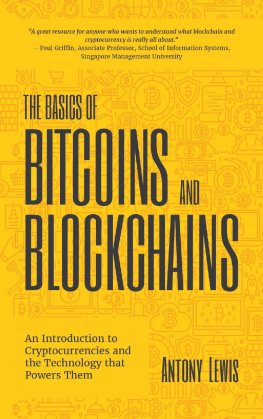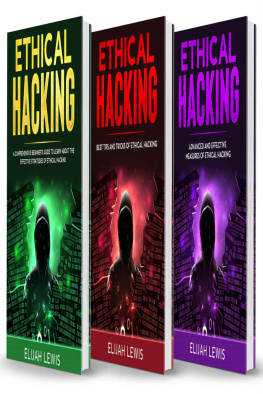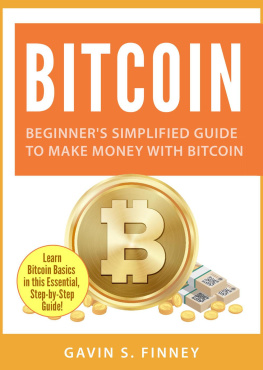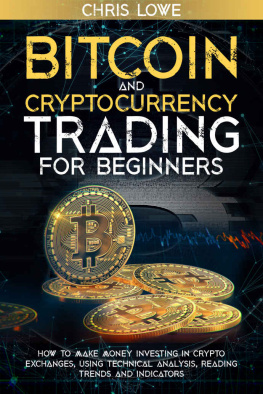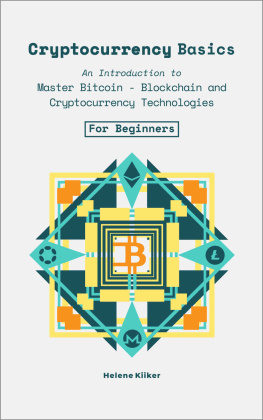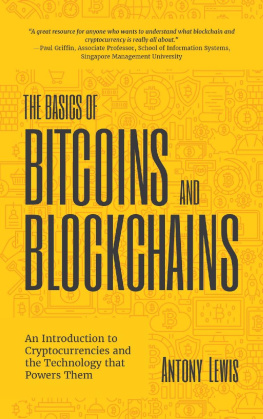The Basics of
Bitcoins and Blockchains
A comprehensive overview of the fundamentals. One of the few recommended readings for my new staff.
Yusho Liu, Cofounder, Coinhako
A useful, usable and enjoyable read. Antony helps us all clearly understand the mechanics of bitcoin and blockchain.
Rob Findlay, Founder, Next Money
A great resource for anyone who wants to understand what blockchain and cryptocurrency is really all about.
Paul Griffin, Associate Professor, School of Information Systems, Singapore Management University
Einstein said that if you cant explain it simply, you dont understand it well enough. Antony clearly understands and articulates the basics of cryptocurrencies and blockchain technologies.
Colin Platt, Co-Host Blockchain Insider Podcast & DLT/Cryptocurrency Researcher
The first book that Ive seen that really breaks down concepts. An excellent insight into the key concepts and real-world implications of bitcoin and blockchain.
Zennon Kapron, Managing Director, Kapronasia
This is a helpful introductory guide to cryptocurrencies.
Tim Swanson, Post Oak Labs and Of Numbers blog
A delightful read that cuts the hype, finds the signal in the noise, and fires on all cylinders from front to back.
John Collins, fintech advisor
My family asked me to explain what I do, I gave them a copy of this book. Antony explains cryptocurrencies and blockchain technologies clearly and articulately, whilst remaining witty.
Colin Platt, Co-Host Blockchain Insider Podcast & DLT/Cryptocurrency Researcher
One of the few credible books I suggest when people ask where can I learn about bitcoin? It is an excellent, level-headed primary on everything crypto. Ive been in the space for quite some time and I still learned from The Basics of Bitcoins and Blockchains.
Zennon Kapron, Managing Director, Kapronasia
An engaging, clear, and authoritative guide to the applications and implications of blockchains.
Greg Wolfson, Head of Business Development at Element Group
If you want a book that over-sells blockchain, go elsewhere. This explains the fundamentals clearly and cuts through
the hype.
Richard Gendal Brown, CTO, R3
The Basics of
Bitcoins and
Blockchains
An Introduction to Cryptocurrencies and the Technology That Powers Them
Antony Lewis

Mango Publishing
Coral Gables
Copyright 2018 Antony Lewis
Published by Mango Publishing Group, a division of Mango Media Inc.
Cover Design: Roberto Nez
Layout & Design: Roberto Nez
Mango is an active supporter of authors rights to free speech and artistic expression in their books. The purpose of copyright is to encourage authors to produce exceptional works that enrich our culture and our open society.
Uploading or distributing photos, scans or any content from this book without prior permission is theft of the authors intellectual property. Please honor the authors work as you would your own. Thank you in advance for respecting our authors rights.
For permission requests, please contact the publisher at:
Mango Publishing Group
2850 Douglas Road, 3rd Floor
Coral Gables, FL 33134 USA
For special orders, quantity sales, course adoptions and corporate sales, please email the publisher at . For trade and wholesale sales, please contact Ingram Publisher Services at:
or +1.800.509.4887.
The Basics of Bitcoins and Blockchains: An Introduction to Cryptocurrencies and the Technology that Powers Them
Library of Congress Cataloging-in-Publication has been applied for.
ISBN: (paperback) 978-1-63353-800-9, (ebook) 978-1-63353-801-6
BISAC category code:
BUSINESS & ECONOMICS / Investments & Securities / Futures
Printed in the United States of America
To my family, my long-suffering wife Sarah and our progeny-chain Toshi and Tosha.
Table of Contents
Bitcoin, blockchains, and cryptocurrencies are fascinating to me because there are so many elements to understand. This multidisciplinary nature is one of the reasons I, and so many others, love the industryit is easy to get sucked into the rabbit hole, and as you try to understand each element, every answer begets more questions. The journey starts with What is Bitcoin? but the explanations and answers come from the disciplines of economics, law, computer science, finance, civil society, history, geopolitics, and more. You could create a pretty comprehensive high school curriculum around Bitcoin and have plenty of material to spare.
And this is the very reason why it is so hard to explain. This book is an attempt to cover the basics. It is aimed at the thinking person but assumes that the reader doesnt have a detailed background in the various disciplines mentioned previously. Different people will find different parts interesting. I try to use analogies where I think they help explain some concepts, but be gentle with me: all analogies break down if stretched too far. And although I have tried to be accurate, there will still be oversimplifications, errors and omissions. What is true today may not be tomorrow: the pace of change is rapid. I am the first to admit that there are limits to my own technical expertise. Nevertheless, I hope that every reader comes away learning something new.
With that, lets start by defining at a basic level some of the words and concepts we will be exploring later in the book.
Bitcoin and Ether are two of the better-known cryptocurrencies or coins (note that the coin on the Ethereum network is called Ether, though is often misnamed in the media as Ethereum). These are assets or items of value that exist digitally, not physically, and are created by software. They have no issuer as such. No person, company, or entity backs these, and there are no terms of service or guarantees associated with them. Like physical gold, cryptocurrencies simply exist, and are created or destroyed according to the rules articulated in the code that creates and governs them. If you own some cryptocurrency, and well see what that actually means later, it is your asset that you control. It has value, and can be exchanged for other cryptocurrencies, US dollars, or other global sovereign (or fiat) currencies. Its value is determined within marketplaces called exchanges where buyers and sellers come together to trade at mutually agreed prices.
As well as coins, units of cryptocurrencies may be described as digital assets. That is, unique data items whose ownership can be passed from account to account. These accounts are technically called addresses, and we will explore what addresses are later. When these digital assets move from one account to another they are all recorded on their respective transaction databases known, because of some unique shared characteristics which we will look into later, as blockchains.
Just to confuse everybody, some digital assets are described as tokens, as in Is it a cryptocurrency or a token?. Cryptocurrencies and tokens are both types of cryptographically secured digital assets, sometimes known as cryptoassets . These tokens have different characteristics from cryptocurrencies and from each other. Tokens can be fungible (one token being more or less replaceable by another), or non-fungible (where each token represents something unique). Unlike cryptocurrencies, these newer tokens are usually issued by known issuers who stand behind them, and the tokens can represent legal agreements (like financial assets), physical assets (like gold), or future access to products and services.
Where the underlying item is an asset you could think of the token as a digital version of a cloakroom ticket, issued by a cloakroom clerk and redeemable for your coat. Indeed, these tokens are sometimes called DDRsDigital Depository Receipts. Where the underlying item is an agreement, product or service, you can think of the token as something like a concert ticket issued by a concert organiser and redeemable for entry to a concert at a later date.
Next page
